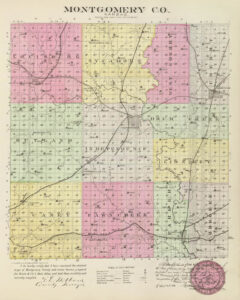Parker, Kansas, an extinct town in Montgomery County, was established in the fall of 1869 by H. N. Martin and Colonel D. T. Parker, after whom it was named.
Located on the east side of the Verdigris River, the founders thought the railroad would run down on the east side of the river, and the site would become the terminal point. This idea became so popular that several people moved to the community. The first building erected was an office occupied by D. T. Parker and F. B. York. A post office was established on November 24, 1869. In little more than a year, it had become a city containing more than 1,000 people with about 50 flourishing businesses.
In 1870, the first school district in the county was organized in Parker. In 1871, Parker was incorporated as a city, and W. Barricklow was elected Mayor; A. D. Keifer, City Clerk; S. S. Peterson, Marshal, and George Hall, T. C. Frazier Dr. Dunwell, F. B. York and John Todd, Councilmen.
However, the early settlers misjudged the plans of the Kansas City, Lawrence, and Southern Kansas Railroad Company, and Coffeyville was established a few miles north, on the opposite side of the river, which became the terminus of the road. Coffeyville soon became the metropolis of southeastern Montgomery County. In the face of these overpowering circumstances, Parker fought bravely for a few months for existence against her rival, but, within no time, many of the businesses moved to Coffeyville.
The post office closed on December 27, 1876. However, it reopened on July 9, 1879.
By the early 1880s, only a few dwellings were left. However, a brick school building was soon built, and William Padon established a mercantile house in the spring of 1882. The post office closed again on March 23, 1882.
The post office reopened on April 2, 1883. It closed its doors for the final time on January 20, 1888.
Parker was located just a few miles north of Coffeyville.
©Kathy Alexander/Legends of Kansas, July 2022.
Also See:

